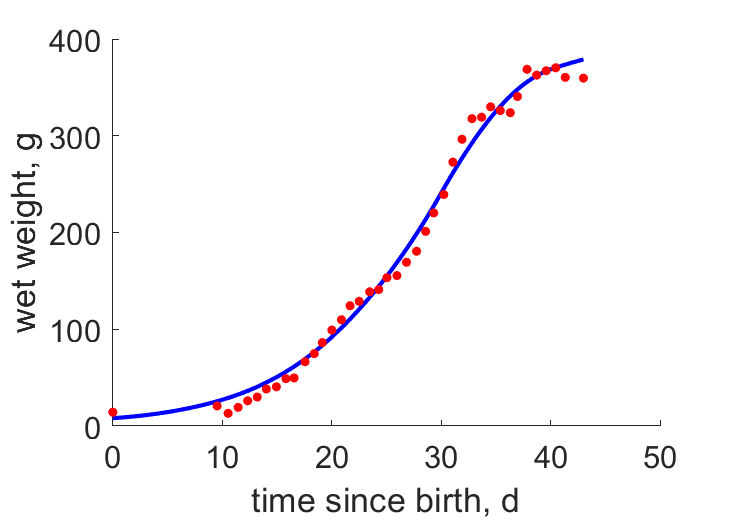Predictions & Data for this entry
| Model: std | climate: BWh, BSh, BSk, Cfa | migrate: Ml | phylum: |
| COMPLETE = 2.5 | ecozone: THn | food: biCi | class: |
| MRE = 0.012 | habitat: 0iTh, 0iTf, 0iTi | gender: Dg | order: |
| SMSE = 0.001 | embryo: Tnpfm | reprod: O | family: |
Zero-variate data
| Data | Observed | Predicted | (RE) | Unit | Description | Reference |
|---|---|---|---|---|---|---|
| ab | 20 | 20.36 | (0.01806) | d | age at birth | avibase |
| tx | 18 | 18.03 | (0.001722) | d | time since birth at fledging | avibase |
| tp | 54 | 54.33 | (0.006037) | d | time since birth at puberty | guess |
| tR | 365 | 365 | ( 0) | d | time since birth at 1st brood | avibase |
| am | 3285 | 3290 | (0.001575) | d | life span | avibase |
| Wwb | 14 | 13.94 | (0.004463) | g | wet weight at birth | avibase |
| Wwi | 286.3 | 285.5 | (0.002837) | g | ultimate wet weight | avibase |
| Wwim | 319.1 | 319.4 | (0.0009194) | g | ultimate wet weight for males | avibase |
| Ri | 0.01946 | 0.01953 | (0.003335) | #/d | maximum reprod rate | avibase |
Uni- and bivariate data
| Data | Figure | Independent variable | Dependent variable | (RE) | Reference |
|---|---|---|---|---|---|
| tW |  | time since birth | wet weight | (0.04598) | Elli2020 |
Pseudo-data at Tref = 20°C
| Data | Generalised animal | Geococcyx californianus | Unit | Description |
|---|---|---|---|---|
| v | 0.02 | 0.02399 | cm/d | energy conductance |
| p_M | 18 | 2344 | J/d.cm^3 | vol-spec som maint |
| k_J | 0.002 | 0.09583 | 1/d | maturity maint rate coefficient |
| k | 0.3 | 0.2993 | - | maintenance ratio |
| kap | 0.8 | 0.9559 | - | allocation fraction to soma |
| kap_G | 0.8 | 0.8002 | - | growth efficiency |
| kap_R | 0.95 | 0.95 | - | reproduction efficiency |
Discussion
- scaled functional response turned out to vary, which has been implemented
- males are supposed to differ from females by {p_Am} only
- mod_1: Pseudo-data point k is used, rather than k_J; Data set tp and parameter t_R are added, the latter replacing clutch interval t_N. Postnatal T is based on PrinPres1991, see get_T_Aves. See further the revision page, theme puberty
Bibliography